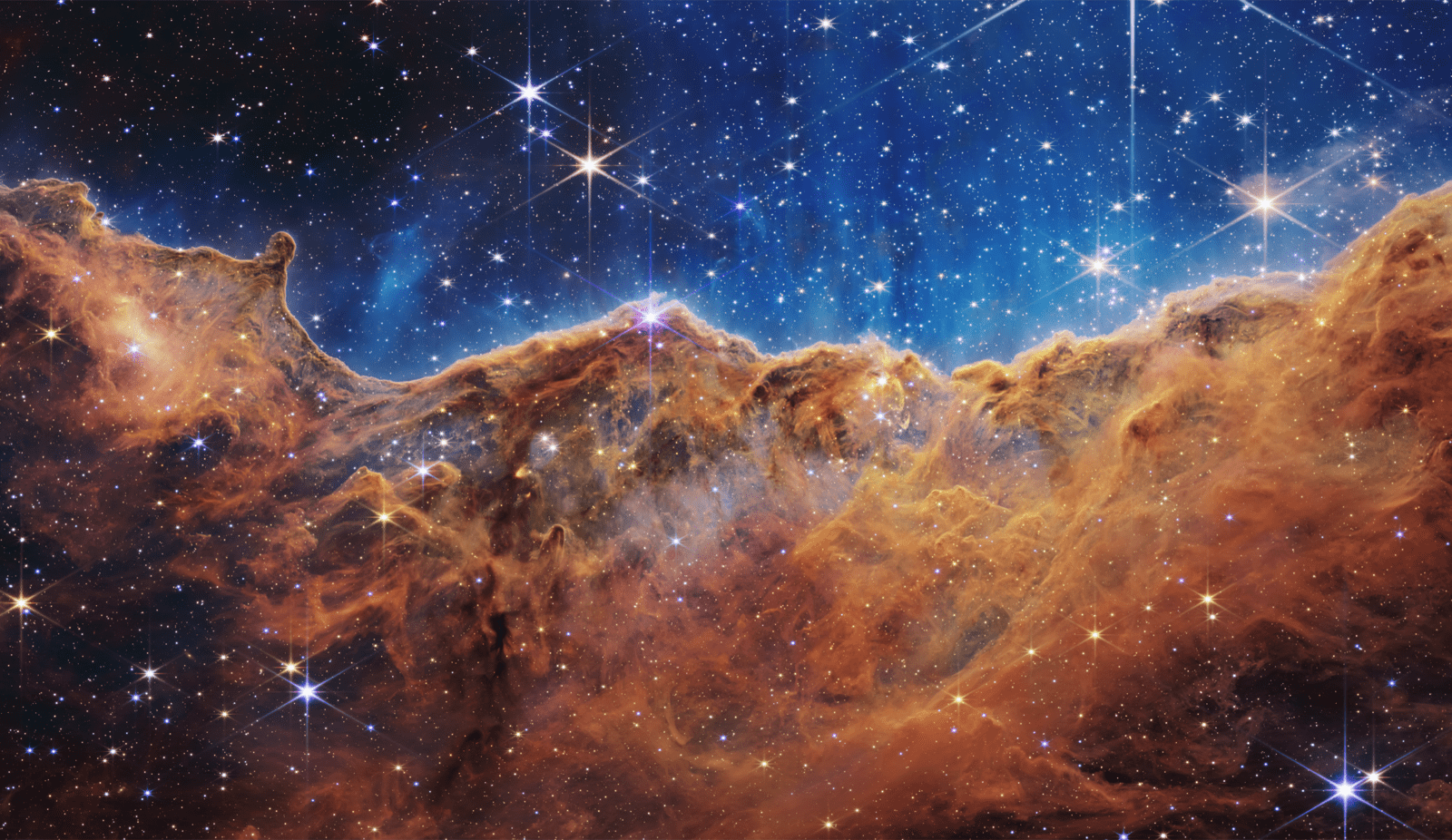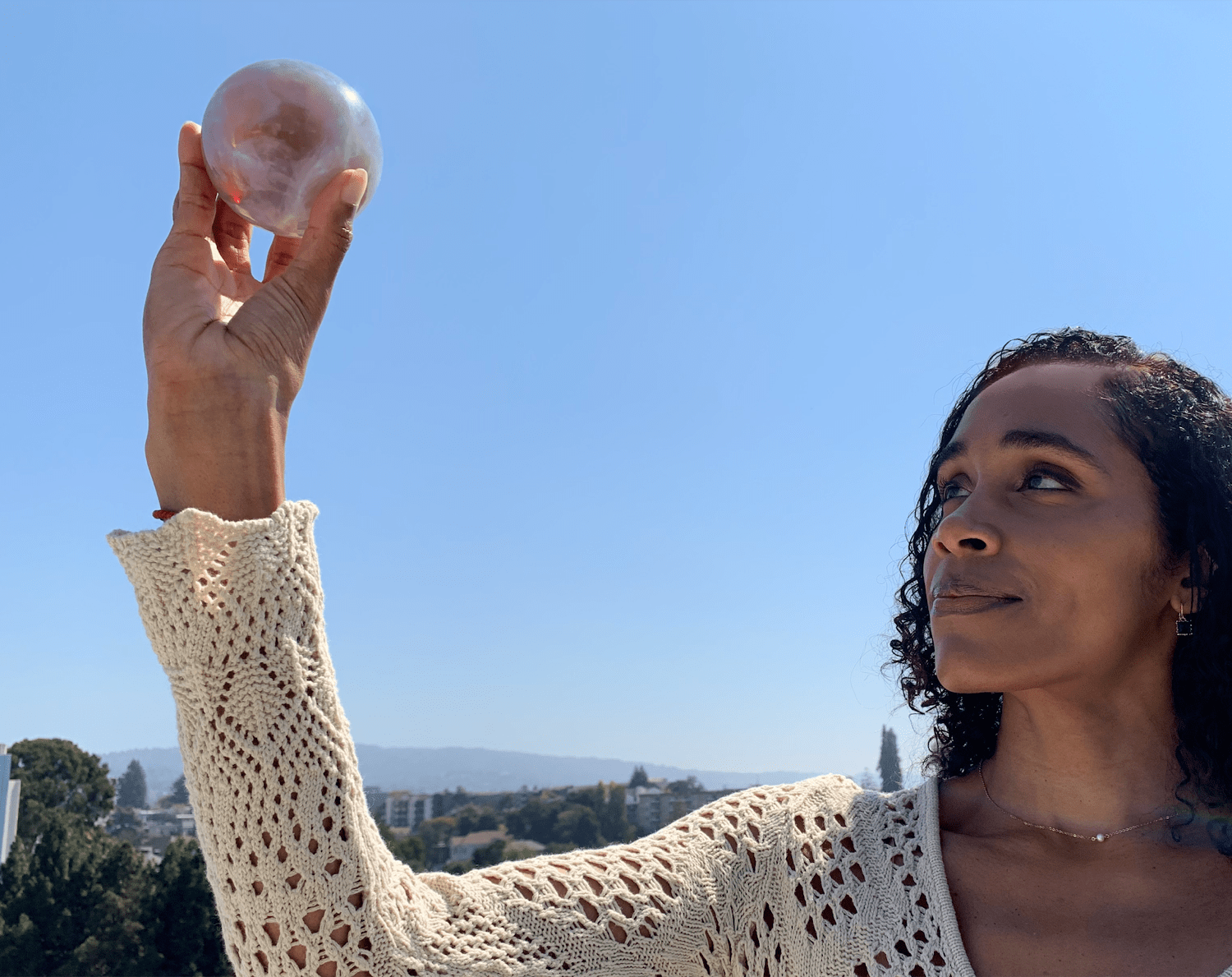This Astrophysicist Holds Star Data In The Palm Of Her Hand
8:53 minutes

When you look into the sky, the space between stars looks empty and void—but it isn’t. That’s where stars are born. And since astronomers and astrophysicists can’t reach these stellar nurseries, they rely on data collected by telescopes to peer into space.

But what if you could hold part of the galaxy in their hands? Or peer into an orb and see the birthplace of stars? By combining astrophysics and art, that’s exactly what Dr. Nia Imara does. She’s a visual artist and assistant professor of astronomy at UC Santa Cruz, based in Santa Cruz, California. Imara talks with Ira about studying stellar nurseries, how she creates stellar nursery spheres, and what she can learn from holding them in her hand.
Invest in quality science journalism by making a donation to Science Friday.
Dr. Nia Imara is a visual artist and an assistant professor of Astronomy at the University of California, Santa Cruz in Santa Cruz, California.
IRA FLATOW: Astronomers and astrophysicists have a bit of a tricky job since they can’t exactly get up close and personal with the stars or deep space they work with. But what if I told you they could virtually hold part of the galaxy in their hands or peer into an orb and see the birthplace of stars? By combining astrophysics and art, that’s exactly what my next guest does Dr. Nia Imara is a visual artist and assistant professor of astronomy at UC Santa Cruz, based in Santa Cruz, California. Nia, welcome to Science Friday.
NIA IMARA: Thanks so much, Ira. I’m really glad to be here.
IRA FLATOW: So to help you answer these big questions about the universe and stars, you create spheres that hold part of the galaxy? Wow. Can you describe how they look and what they represent?
NIA IMARA: So I describe these as sort of giant marbles or even sort of like crystal balls. These spheres are about 8 centimeters in diameter, a little smaller than a softball, so you can hold them in the palm of your hand. And they represent stellar nurseries. They represent the space between the stars where stars are born.
I am a painter in addition to being an astronomer. And years ago, I created this self portrait where I’m touching the stars. And it was years later where I suddenly had the idea, why not actually try to touch the stars, or at least the birthplaces of stars, to try to understand them better?
IRA FLATOW: How do you study these stellar nurseries, and how do you collect the data to know what to put into these spheres?
NIA IMARA: So many of our observations of stellar nurseries come from radio telescopes and infrared telescopes. Much of the physical information that we have about these environments comes directly from these observations and what we infer from these observations. And so we can take these ingredients and sort of put them into the computer codes that we use to ultimately create the orbs that are used to represent the stellar nurseries.
IRA FLATOW: I’d love to dive into how you make them. But first, I want to learn more about what you can learn from studying stellar nurseries.
NIA IMARA: These are where stars are born. And one of the most important questions in modern astrophysics is to understand the life cycle of stars. And that really begins in stellar nurseries, or as astronomers call them, giant molecular clouds. So these stellar nurseries, or molecular clouds, they exist throughout our galaxy and throughout most other galaxies in the universe. And so we would really like to understand how they evolve, how their evolution leads to the formation of stars so we can have a more comprehensive view not only of star formation but how galaxies themselves evolve.
IRA FLATOW: So you take this one stellar nursery, and you make it into one sphere, right? And it ends up being this beautiful orb with swirls of blues and grays and browns. And it really feels like you’re peering into space. Now, how do you use the data to make those orbs? Do you 3D print them?
NIA IMARA: Exactly. And so I had the idea that because these environments are so complex– if you look at these beautiful pictures of the Carina Nebula, for instance, that just came from the James Webb Space Telescope, you can see how intricate and complex they are. And so I had the idea that in order to visualize them in a different way and to really get a grip of these complex environments and how that relates to star formation, why not make a three-dimensional model of these environments?
IRA FLATOW: Does it really help to actually hold something in your hand? Does that really add new information for you?
NIA IMARA: Absolutely. We’re learning quite a bit from these prints. I sort like to think of them as interactive simulations. Astronomers learn a lot about simulations because they allow us to look at all sides of a physical object. They allow us to see how time elapses and sort of witness the evolution of various phenomenon and objects in a compressed time.
And so humans are great at pattern recognition. And with a three-dimensional object in our hand, we’re able to perceive certain patterns and notice connections that we don’t necessarily see on a two-dimensional computer screen or a piece of paper. And so we’re learning quite a bit about the complexity of these environments and how the physical structure of stellar nurseries ultimately leads to the formation of stars.
IRA FLATOW: That’s so interesting. Can you walk me through the process of creating these orbs step by step?
NIA IMARA: The idea is we would like to visualize these objects in their full three dimensions. And so we take these ingredients that we have, all of the physics about gravity and magnetic fields, and we code that into a computer simulation. And so these simulations are representing the interstellar medium, the space between stars. Once a simulation is finished, we take that information from the simulation, which includes basically the physical structure of the environment, how the density of the gas and dust that makes up a stellar nursery– how that material is distributed.
We put that information into a form that a 3D printer can understand. And then finally, we feed that information into the 3D printer, and it prints, layer by layer, that information from the computer simulation. And the output is one of these 3D prints, one of these orbs that represents a vast stellar nursery that could be hundreds of light years across that we can now hold in the palm of our hand.
IRA FLATOW: Do you feel something special when you’re holding one of these in your hand, like you’ve entered another dimension?
NIA IMARA: It does feel special. I think the wonderful thing about astronomy is that it’s very humbling. And on the one hand, it really speaks to the power of human imagination and the power of the human mind to conceptualize these sorts of things. And on the other hand, it’s very humbling because we know that, as cool as these spheres are, they don’t necessarily represent the absolute truth. And there’s so much more for us to learn. And so they open up quite a few questions, perhaps opening more questions than we started out with.
IRA FLATOW: Do you have an example of something that you learned that you would not have noticed in a 2D image?
NIA IMARA: One of the things that we know from two-dimensional images is that stars are born within certain regions of stellar nurseries. And in particular, they’re born in the densest regions, where the gas and the dust is the most compact and dense. However, we can’t get a full idea of what’s happening and to the depth of these stellar nurseries just based on these flat images.
And so for instance, we see these long, skinny, very dense structures where stars seem to prefer to be born. And they seem sort of like long, skinny cigars or pieces of licorice that sort of wind their way through the cloud. When we see these similar objects in a three-dimensional print, oftentimes they’re actually sheets, so sort of two-dimensional flat structures, more like pancakes, let’s say, that are viewed in projection. And so this raises the tantalizing idea that perhaps filaments emerge from sheet-like structures and that the evolution from the beginning stages of a molecular cloud to a star may be more complex than we had envisioned.
IRA FLATOW: That is very interesting. If you step back a little bit and look at the larger concept and idea of what you are doing, the intersection of art and science, it sounds like this is very important to you.
NIA IMARA: I think that art and science are two different ways of looking at the world. And we often pose very similar questions as artists and scientists. The question that unites these two fields for me is really about where we come from, where people come from. And I think the greatest lessons of astronomy for me is that it really shows us that we’re united. We all come from the stars, quite literally.
IRA FLATOW: I’m fascinated by your work, and it would be great to see you continue what you’re doing.
NIA IMARA: Thank you.
IRA FLATOW: Dr. Nia Imara is a visual artist and an assistant professor of astronomy at UC Santa Cruz, based in Santa Cruz, California.
Copyright © 2022 Science Friday Initiative. All rights reserved. Science Friday transcripts are produced on a tight deadline by 3Play Media. Fidelity to the original aired/published audio or video file might vary, and text might be updated or amended in the future. For the authoritative record of Science Friday’s programming, please visit the original aired/published recording. For terms of use and more information, visit our policies pages at http://www.sciencefriday.com/about/policies/.
Rasha Aridi is a producer for Science Friday and the inaugural Outrider/Burroughs Wellcome Fund Fellow. She loves stories about weird critters, science adventures, and the intersection of science and history.
As Science Friday’s director and senior producer, Charles Bergquist channels the chaos of a live production studio into something sounding like a radio program. Favorite topics include planetary sciences, chemistry, materials, and shiny things with blinking lights.
Ira Flatow is the founder and host of Science Friday. His green thumb has revived many an office plant at death’s door.